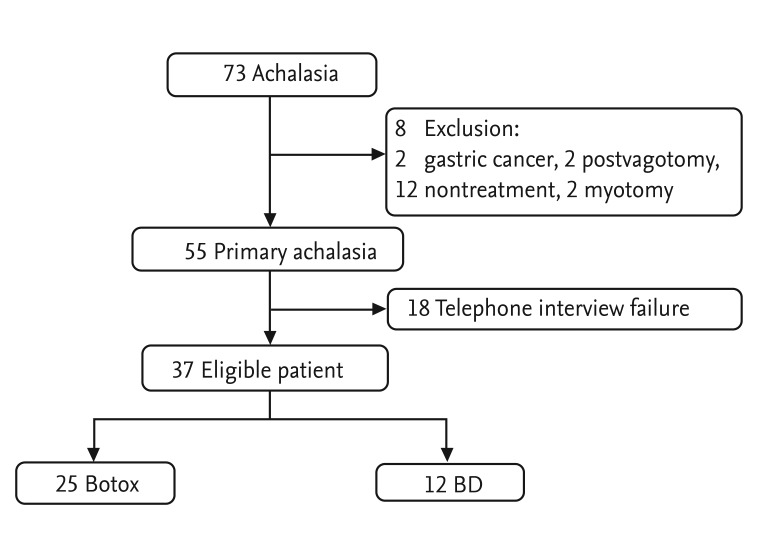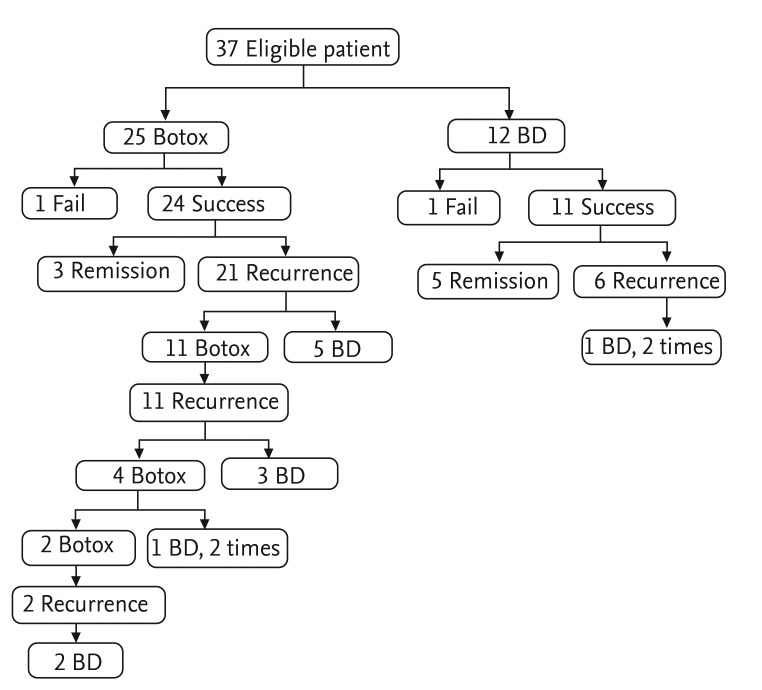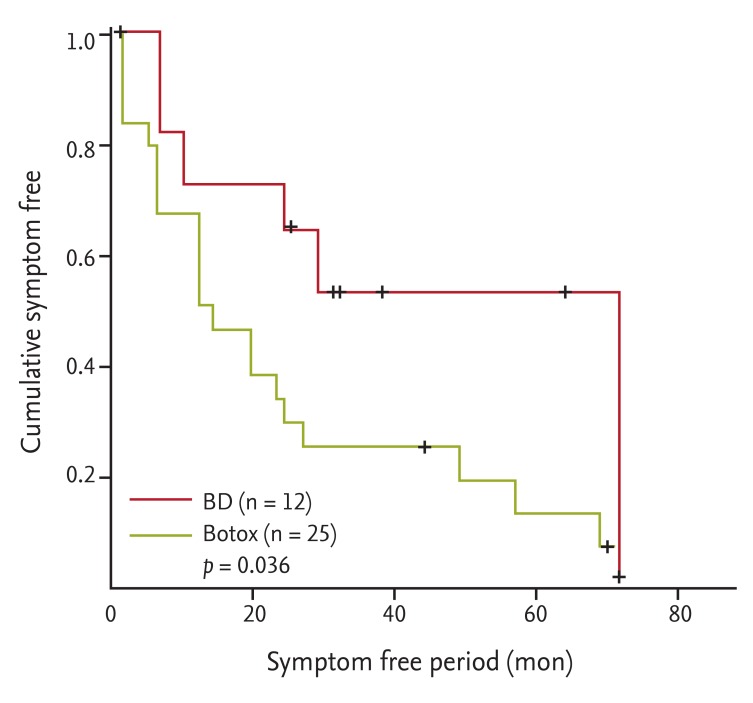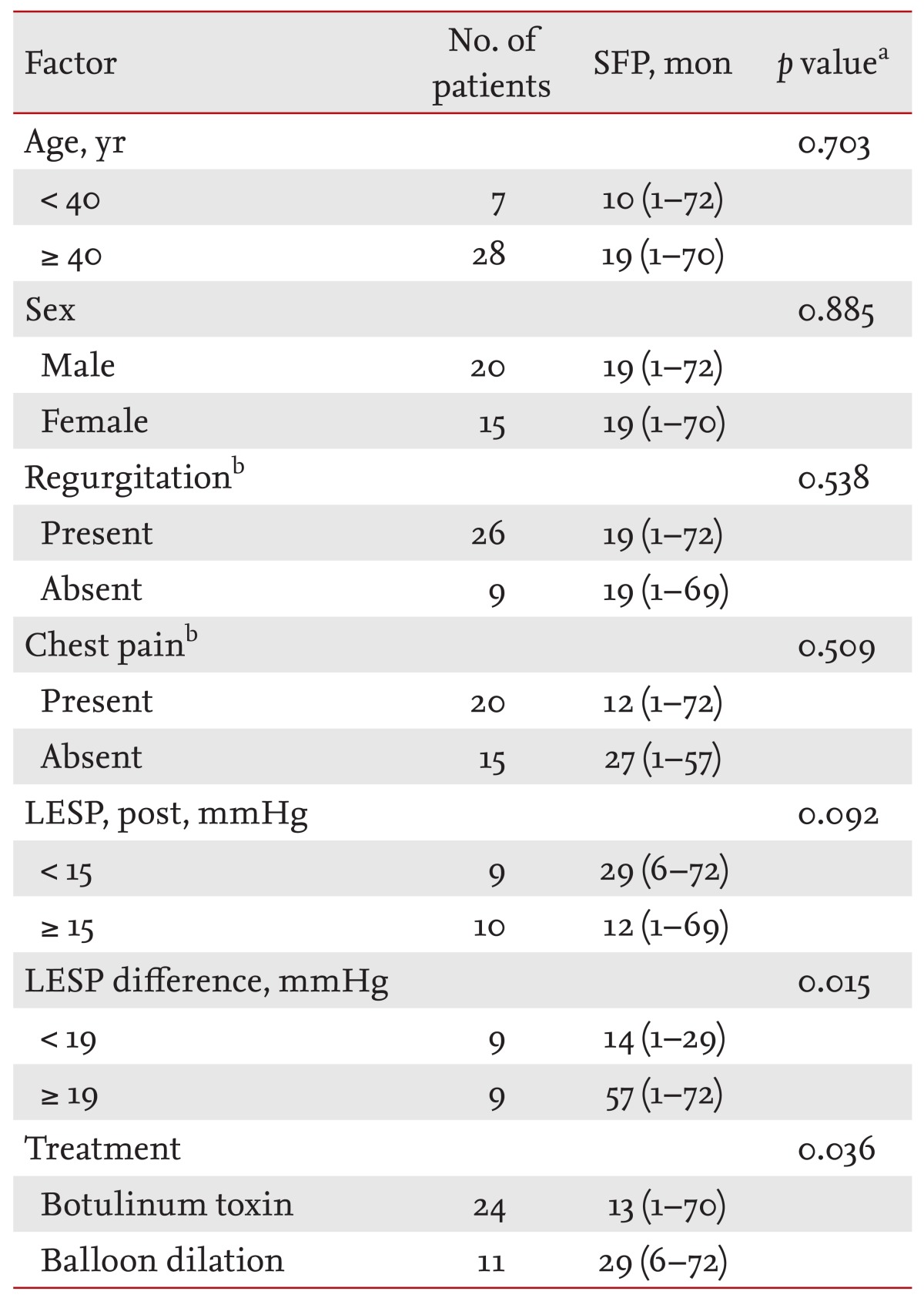4. Lee JS. Endoscopic treatment of primary esophageal motility disorders. Korean J Gastrointest Endosc 2011;42:341–348.
6. Mikaeli J, Fazel A, Montazeri G, Yaghoobi M, Malekzadeh R. Randomized controlled trial comparing botulinum toxin injection to pneumatic dilatation for the treatment of achalasia. Aliment Pharmacol Ther 2001;15:1389–1396PMID : 11552910.


7. Annese V, Basciani M, Perri F, et al. Controlled trial of botulinum toxin injection versus placebo and pneumatic dilation in achalasia. Gastroenterology 1996;111:1418–1424PMID : 8942719.


9. Ghoshal UC, Chaudhuri S, Pal BB, Dhar K, Ray G, Banerjee PK. Randomized controlled trial of intrasphincteric botulinum toxin A injection versus balloon dilatation in treatment of achalasia cardia. Dis Esophagus 2001;14:227–231PMID : 11869325.


10. Nam SM, Kim JS, Kim SG, Jung HC, Song IS. Long-term efficacy of pneumatic dilatation in primary achalasia. Korean J Gastrointest Endosc 2002;25:63–69.
12. Sym SJ, Jung HY, Jo CL, et al. Predictors of outcome in patients with primary achalasia treated by pneumatic dilation. Korean J Gastrointest Endosc 2002;25:187–191.
14. Vaezi MF. Quantitative methods to determine efficacy of treatment in achalasia. Gastrointest Endosc Clin N Am 2001;11:409–424PMID : 11319070.


15. Shen YY, Shiau YC, Sun SS, Kao CH. Using radionuclide esophageal emptying test to evaluate pneumatic dilatation effects for achalasia. Hepatogastroenterology 2001;48:1061–1063PMID : 11490800.

17. Song CS, Yu YI, Park SK, et al. Predictors of successful balloon dilation in patients with achalasia: especially in patients who showed peristalsis after dilation. Korean J Med 1998;54:666–674.
19. Bansal R, Nostrant TT, Scheiman JM, et al. Intrasphincteric botulinum toxin versus pneumatic balloon dilation for treatment of primary achalasia. J Clin Gastroenterol 2003;36:209–214PMID : 12590230.


20. Gutschow CA, Tox U, Leers J, Schafer H, Prenzel KL, Holscher AH. Botox, dilation, or myotomy? Clinical outcome of interventional and surgical therapies for achalasia. Langenbecks Arch Surg 2010;395:1093–1099PMID : 20845045.


22. Moon JT, Jung IS, Kim YS, Cho SH, Park H, Lee SI. Correlation between clinical symptoms and radiologic findings before and after pneumatic balloon dilatation for achalasia. Korean J Gastroenterol 2008;52:16–20PMID : 19077486.

23. Song CW, Jeen YT, Um SH, Kim CD, Ryu HS, Hyun JH. Predictors of symptom improvement and recurrence in patients with achalasia treated by pneumatic balloon dilation. Korean J Gastroenterol 1997;29:279–288.
24. Boeckxstaens GE, Annese V, des Varannes SB, et al. Pneumatic dilation versus laparoscopic Heller's myotomy for idiopathic achalasia. N Engl J Med 2011;364:1807–1816PMID : 21561346.


25. Inoue H, Minami H, Kobayashi Y, et al. Peroral endoscopic myotomy (POEM) for esophageal achalasia. Endoscopy 2010;42:265–271PMID : 20354937.


26. von Renteln D, Inoue H, Minami H, et al. Peroral endoscopic myotomy for the treatment of achalasia: a prospective single center study. Am J Gastroenterol 2012;107:411–417PMID : 22068665.


27. Micci MA, Kahrig KM, Simmons RS, Sarna SK, Espejo-Navarro MR, Pasricha PJ. Neural stem cell transplantation in the stomach rescues gastric function in neuronal nitric oxide synthase-deficient mice. Gastroenterology 2005;129:1817–1824PMID : 16344050.












 PDF Links
PDF Links PubReader
PubReader ePub Link
ePub Link Full text via DOI
Full text via DOI Download Citation
Download Citation Print
Print





